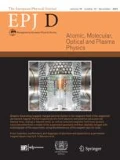Abstract
The large molecules lie in the “border territory" between the “quantum" and the “classical". To which extent one should employ the classical or quantum-mechanical methods in describing their behavior is an open issue. To this end, the problem of the large-molecules conformational stability and transitions is typical. While the small or medium-size molecules are successfully described by the quantum mechanical methods, the large-molecules conformational transitions are usually investigated classically. However, the problem of the origin of stability of the large-molecules conformations remains open. In this paper, we offer a solution-in-principle for both the large-molecules conformational stability and transitions yet in the context of the quantum decoherence theory. Actually, we apply the “environment-induced superselection rules" theory that naturally answers both of the problems, and, in a sense, offers a unifying picture for the molecules in a solution. Generality of our approach stems from the generality of the decoherence theory. So, our approach is a qualitative theoretical program alternating the point of view to the large-molecules dynamics: while ultimately being the quantum-mechanical systems, the large molecules in a solution may still exhibit the (approximately) classical behavior of their conformational degrees of freedom.
Similar content being viewed by others
References
M. Quack, Angew. Chem. Int. Ed. Engl. 28, 571 (1989)
D. Giulini et al., Decoherence and the Appearance of a Classical World in Quantum Theory (Springer, Berlin, 1996)
C. Levinthal, J. Chem. Phys. 65, 44 (1968)
P. Echenique, Contemp. Phys. 48, 81 (2007)
R.A.L. Jones, Soft Machines: Nanotechnology and Life (Oxford Univ. Press, Oxford, 2004)
M.B. Jackson, Molecular and Cellular Biophysics (Cambridge Univ. Press, Cambridge, 2006)
K.A. Dill, H.S. Chan, Nature Struct. Biol. 4, 10 (1997)
H.S. Chan, K.A. Dill, Proteins 30, 2 (1998)
A. Messiah, Quantum Mechanics (North-Holland, Amsterdam, 1976)
M.V. Volkenstein et al., Molecular Vibrations (Nauka, Moscow, 1972) (in Russian)
P. Atkins, R. Friedman, Molecular Quantum Mechanics (Oxford Univ. Press, Oxford, 2005)
K. Hoki et al., J. Phys. Chem. A 108, 6455 (2004)
B. Dietzek et al., J. Phys. Chem. B 111, 6034 (2007)
E. Frishman et al., J. Phys. B 37, 2811 (2004)
D. Raković et al., Materials Science Forum 453-454, 521 (2004)
W.H. Zurek, Phys. Rev. D 26, 1862 (1982)
M. Dugić, Physica Scripta 53, 9 (1996)
M. Dugić, Physica Scripta 56, 560 (1997)
K.A. Dill, Protein Science 8, 1166 (1999)
A. Lendlein et al., Nature 434, 879 (2005)
S. Kachalo et al., Rev. Lett. 96, 058106 (2006)
L. Hackermuller et al., Phys. Rev. Lett. 91, 090408 (2003)
L. Hackermuller et al., Nature 427, 711 (2004)
P. Grigolini, Quantum Mechanical Irreversibility and Measurement (World Scientific, Singapore, 1993)
M. Wiesniak et al., Phys. Rev. B 78, 064108 (2008)
W.H. Zurek, in Frontiers in Nonequilibrium Statistical Physics, edited by G.T. Moore, M.T. Sculley (Plenum, New York, 1986)
J. Von Neumann, Mathematical Foundations of Quantum Mechanics (Princeton University Press, Princeton, 1955)
R. Omnes, The Interpretation of Quantum Mechanics (Princeton University Press, Princeton, 1994)
G. Hagedorn, Commun. Math. Phys. 77, 1 (1980)
K. Kraus, States, Effects and Operations (Springer-Verlag, Berlin, 1983)
M. Nielsen, I. Chuang, Quantum Computation and Quantum Information (Cambridge Univ. Press, Cambridge, 2000)
G. Jona-Lasinio, P. Clevarie, Prog. Theor. Phys. Suppl. 86, 54 (1986)
J.P. Paz, W.H. Zurek, Phys. Rev. Lett. 82, 5181 (1999)
C.B. Anfinsen et al., Proc. Natl. Acad. Sci. USA 47, 1309 (1961)
L.A. Gribov, From the Theory of Spectra Towards the Theory of Chemical Reactions (Russian Academy of Science, Moscow, 2001) (in Russian)
N. Margolus, L.B. Levitin, Physica D 120, 188 (1998)
M. Dugić, M.M. Ćirković, Phys. Lett. A 302, 291 (2002)
Author information
Authors and Affiliations
Corresponding author
Rights and permissions
About this article
Cite this article
Jeknić-Dugić, J. The environment-induced-superselection model of the large-molecules conformational stability and transitions. Eur. Phys. J. D 51, 193–204 (2009). https://doi.org/10.1140/epjd/e2009-00005-1
Received:
Revised:
Published:
Issue Date:
DOI: https://doi.org/10.1140/epjd/e2009-00005-1




